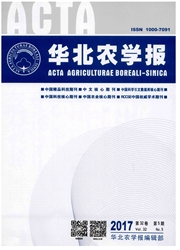

 中文摘要:
中文摘要:
The construction of high density genetic linkage map provides a powerful tool to detect and map quantitative trait loci (QTLs) controlling agronomically important traits. In this study, simple sequence repeat (SSR) markers and Illumina 9K iSelect single nucleotide polymorphism (SNP) genechip were employed to construct one genetic linkage map of common wheat (Triticum aestivum L.) using 191 recombinant inbred lines (RILs) derived from cross Yu 8679xJing 411. This map included 1 901 SNP loci and 178 SSR loci, covering 1 659.9 cM and 1 000 marker bins, with an average interval distance of 1.66 cM. A, B and D genomes covered 719.1,703.5 and 237.3 cM, with an average interval distance of 1.66, 1.45 and 2.9 cM, respectively. Notably, the genetic linkage map covered 20 chromosomes, with the exception of chromosome 5D. Bioinformatics analysis revealed that 1 754 (92.27%) of 1 901 mapped SNP loci could be aligned to 1 215 distinct wheat unigenes, among which 1 184 (97.4%) were located on one single chromosome, and the rest 31 (2.6%) were located on 2 to 3 chromosomes. By performing in silico comparison, 214 chromosome deletion bin-mapped expressed sequence tags (ESTs), 1 043 Brachypodium genes and 1 033 rice genes were further added onto the genetic linkage map. This map not only integrated genetic and physical maps, SSR and SNP loci, respectively, but also provided the information of Brachypodium and rice genes corresponding to 1 754 SNP loci. Therefore, it will be a useful tool for comparative genomics analysis, fine mapping of QTL/gene controlling agronomically important traits and marker-assisted selection breeding in wheat.
 同期刊论文项目
同期刊论文项目
 同项目期刊论文
同项目期刊论文
 期刊信息
期刊信息
